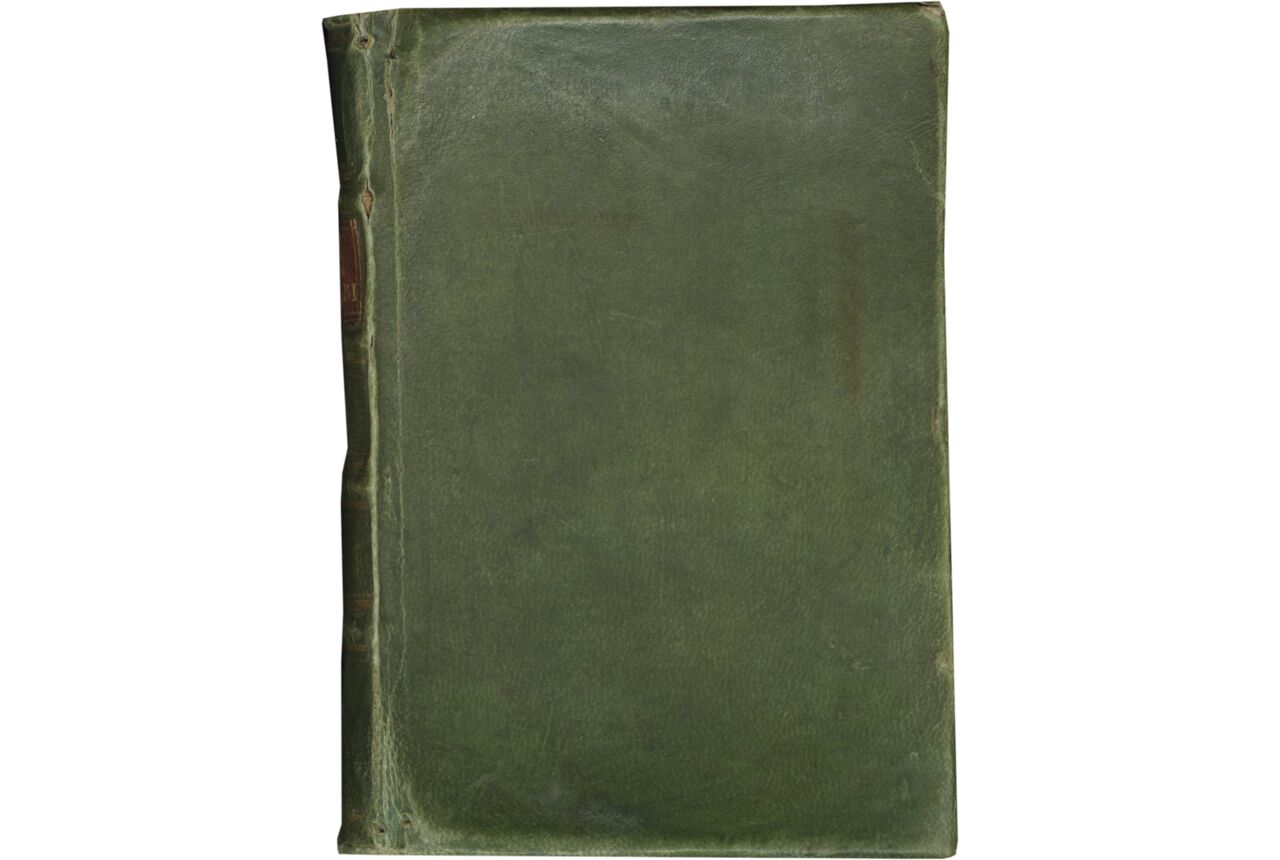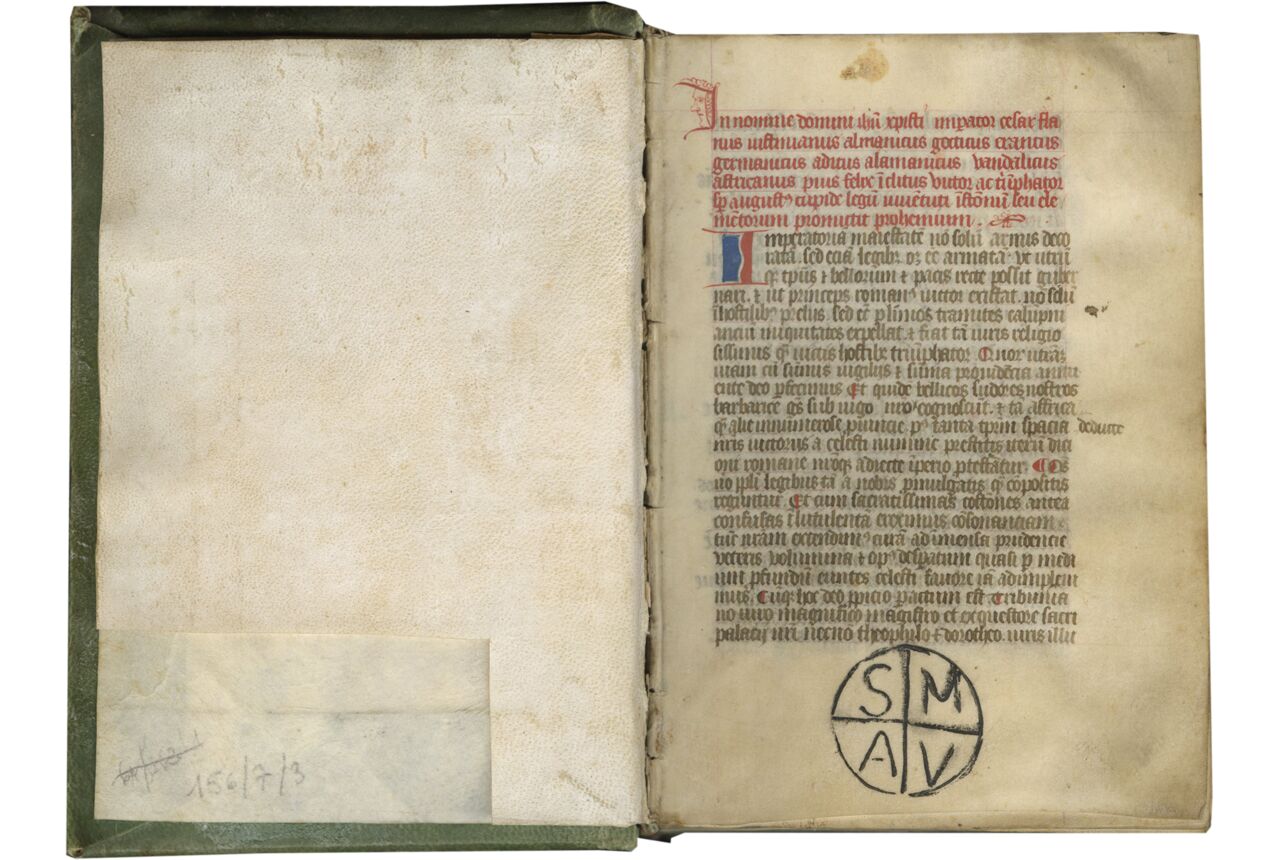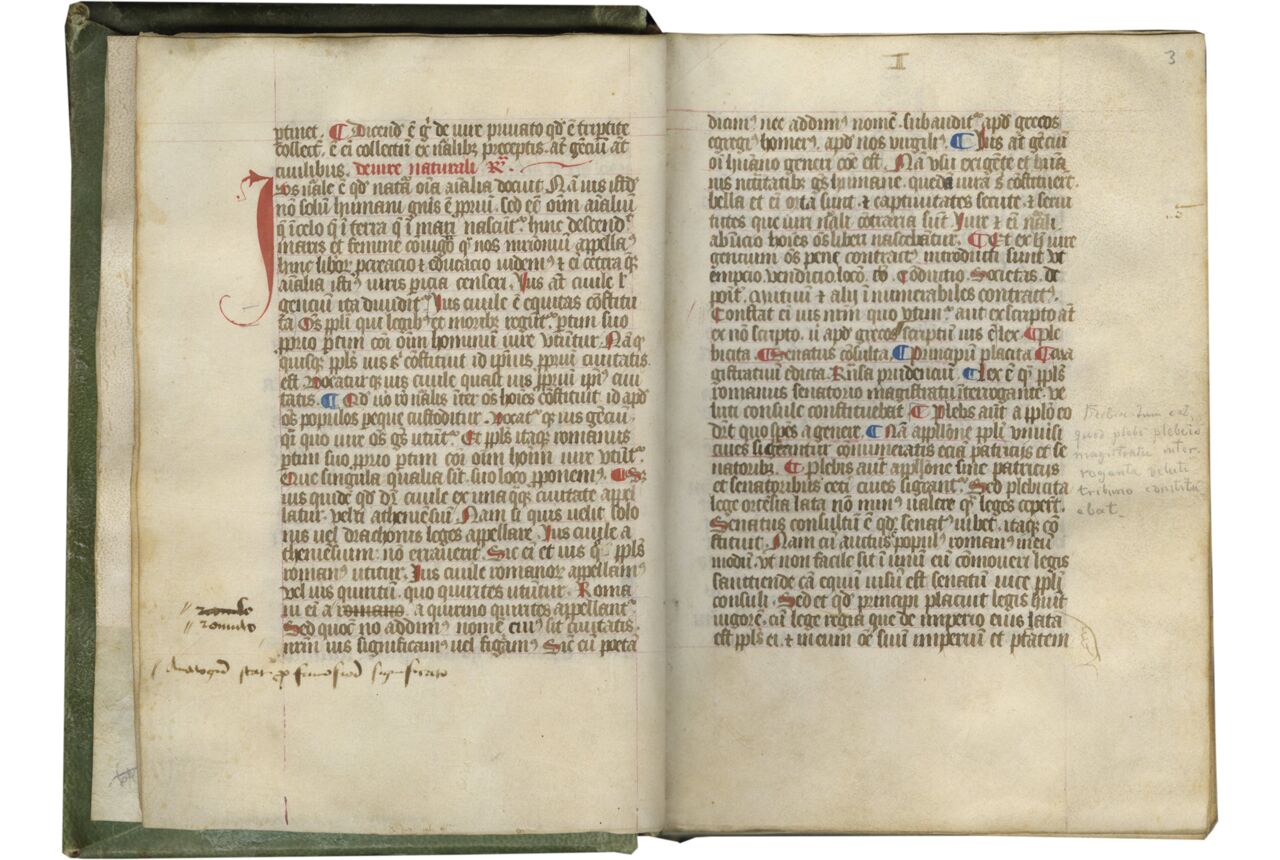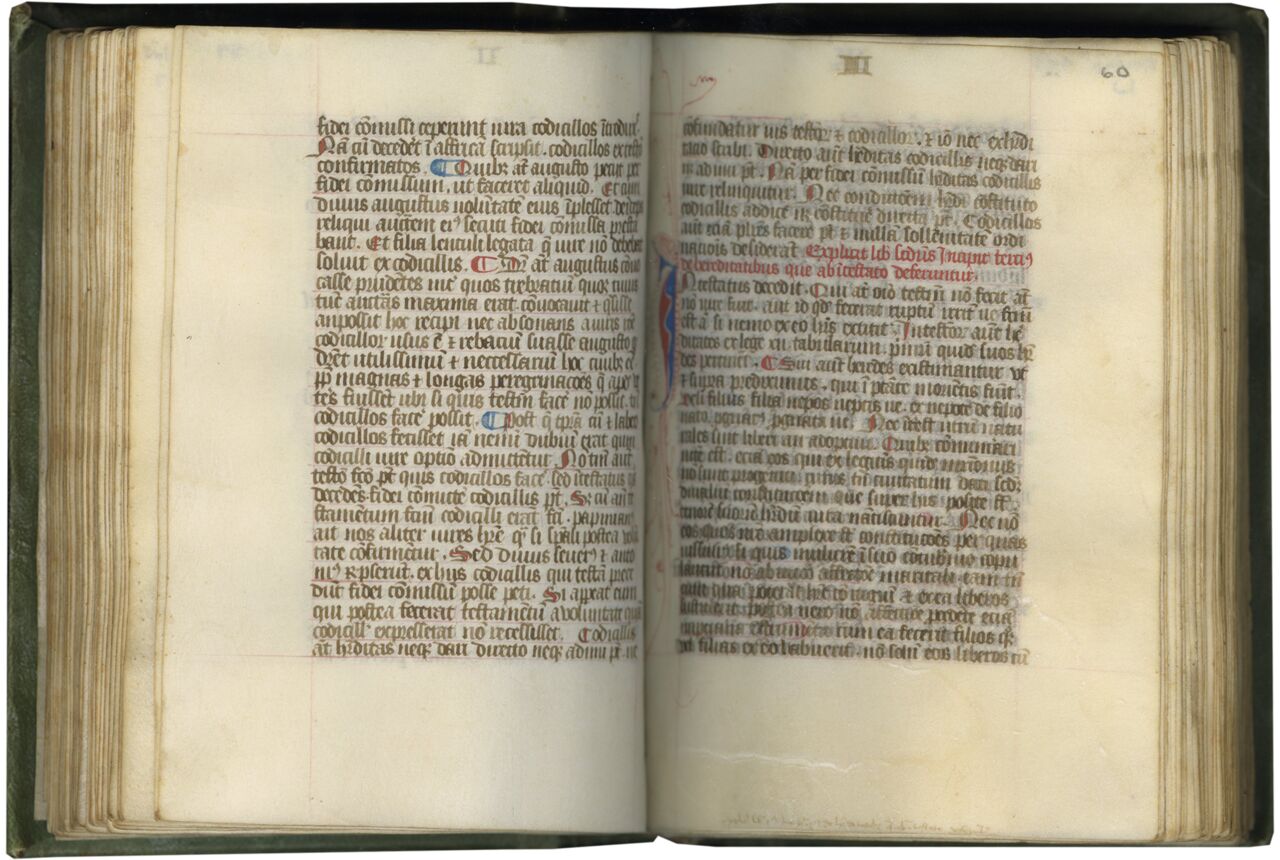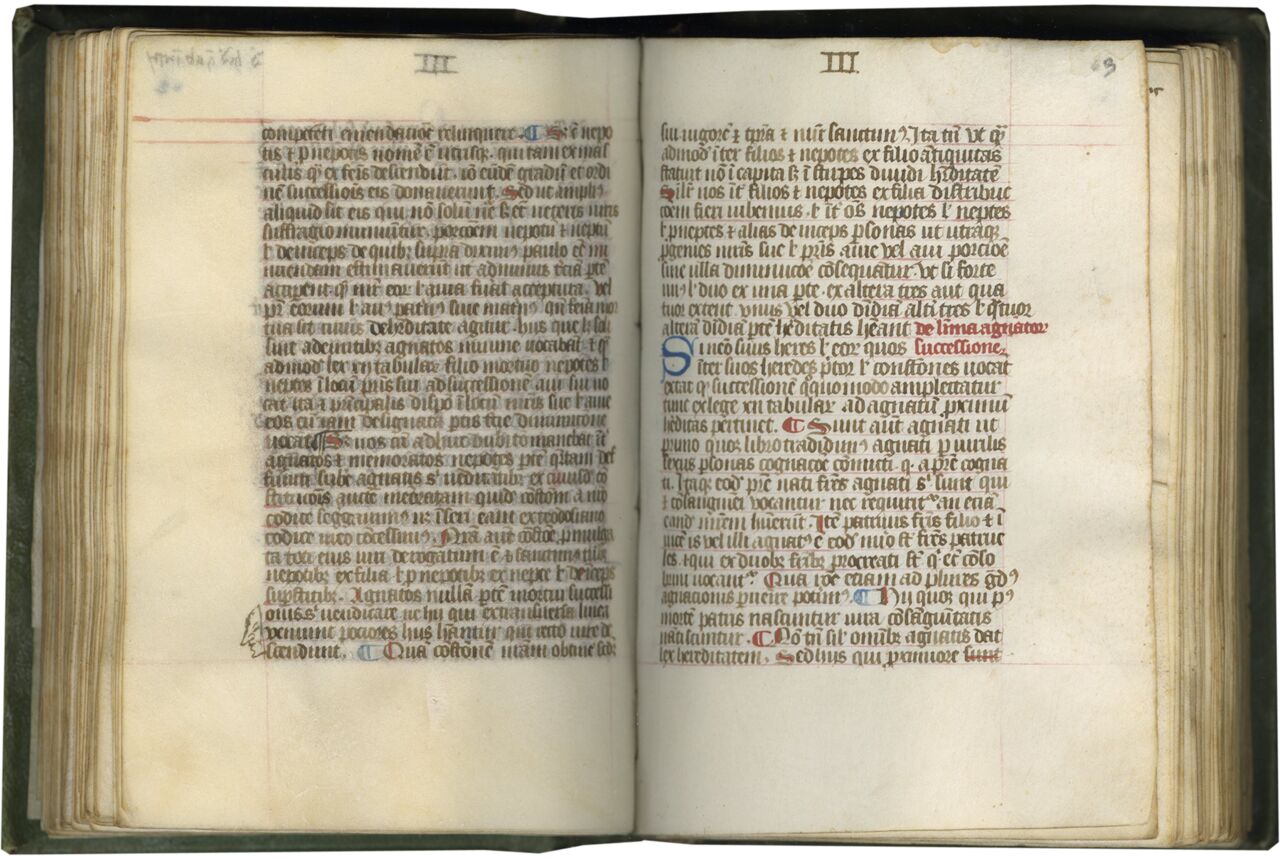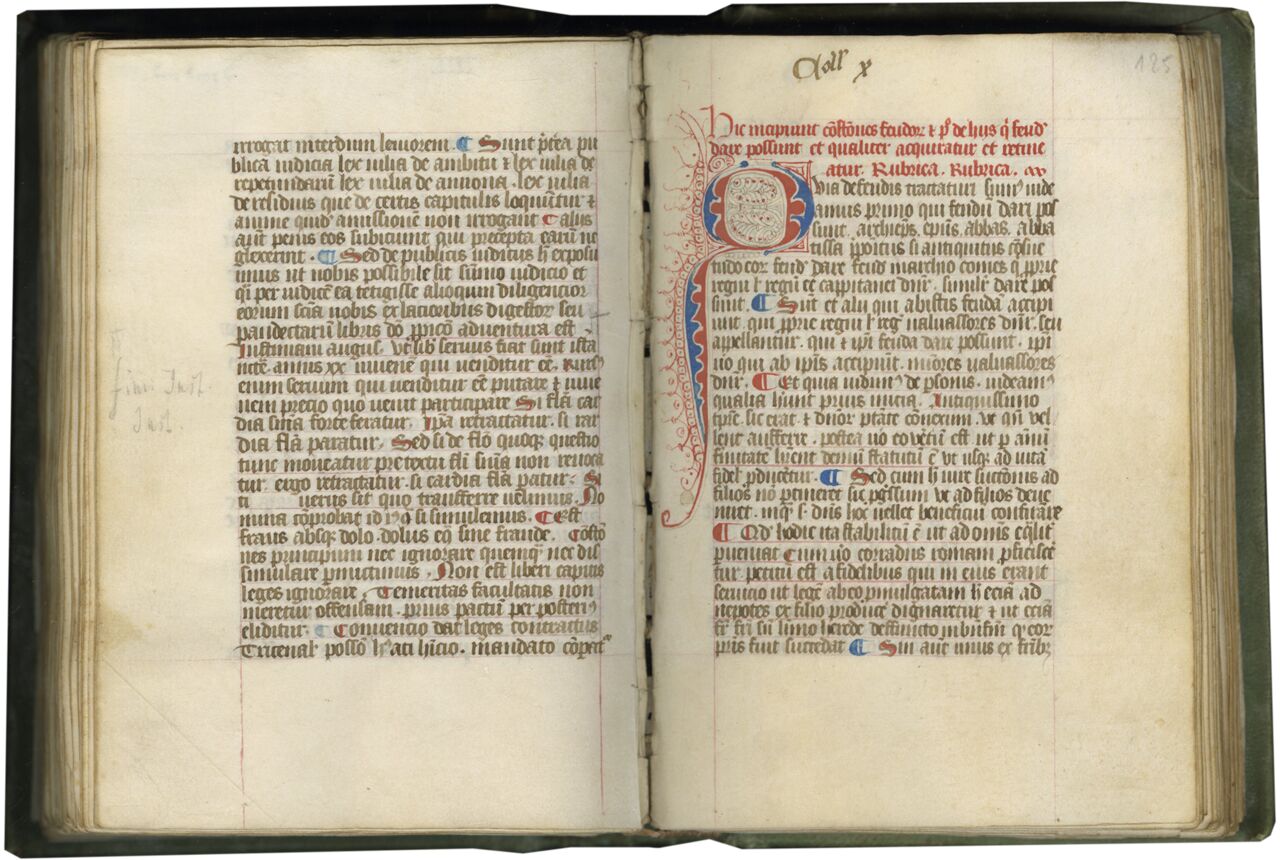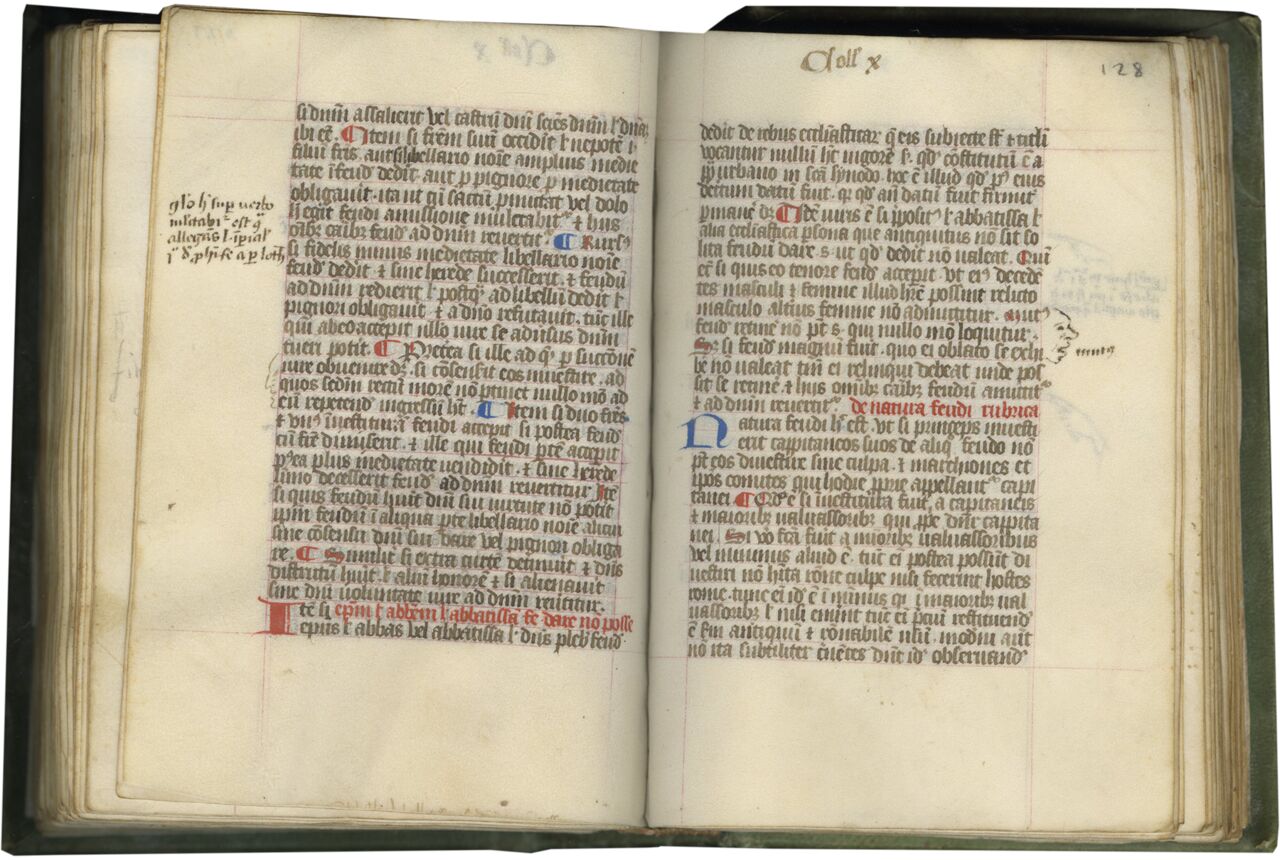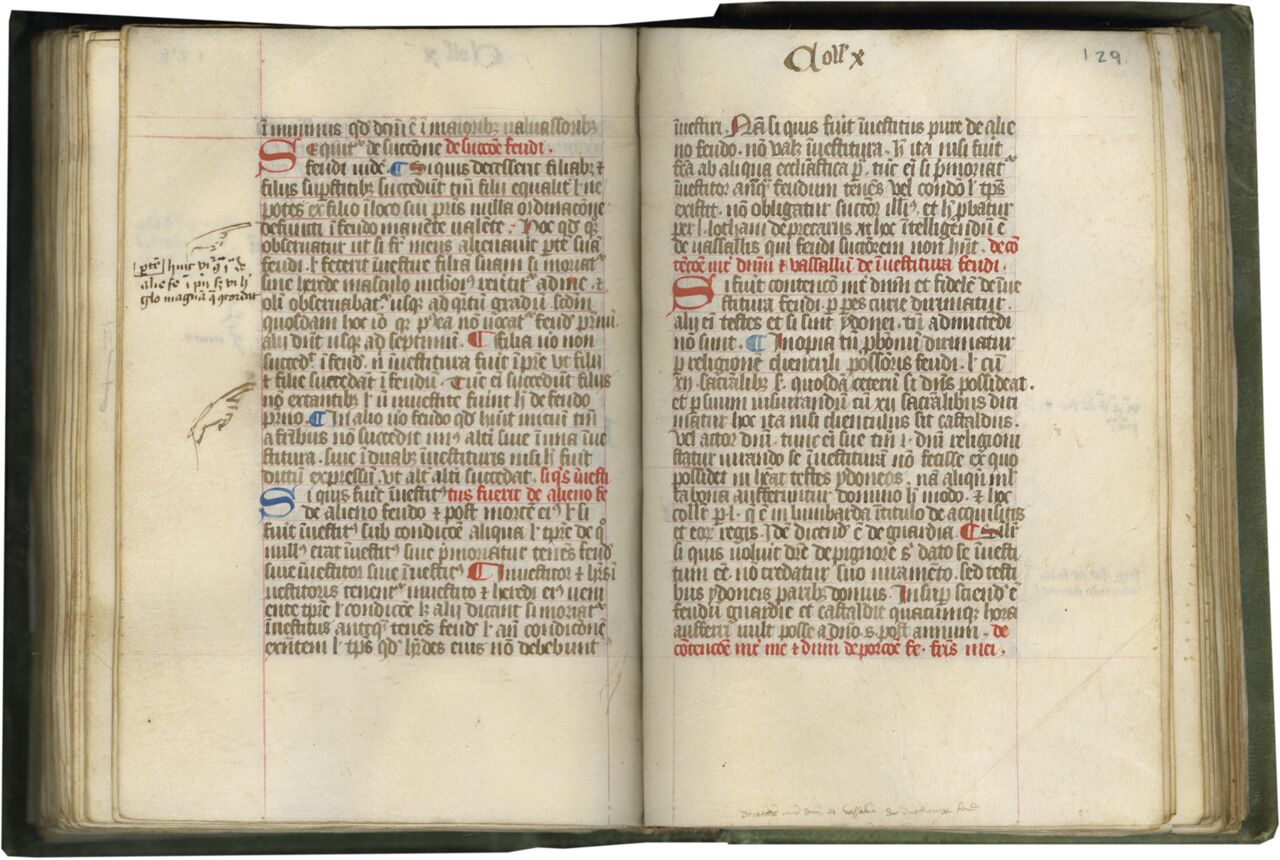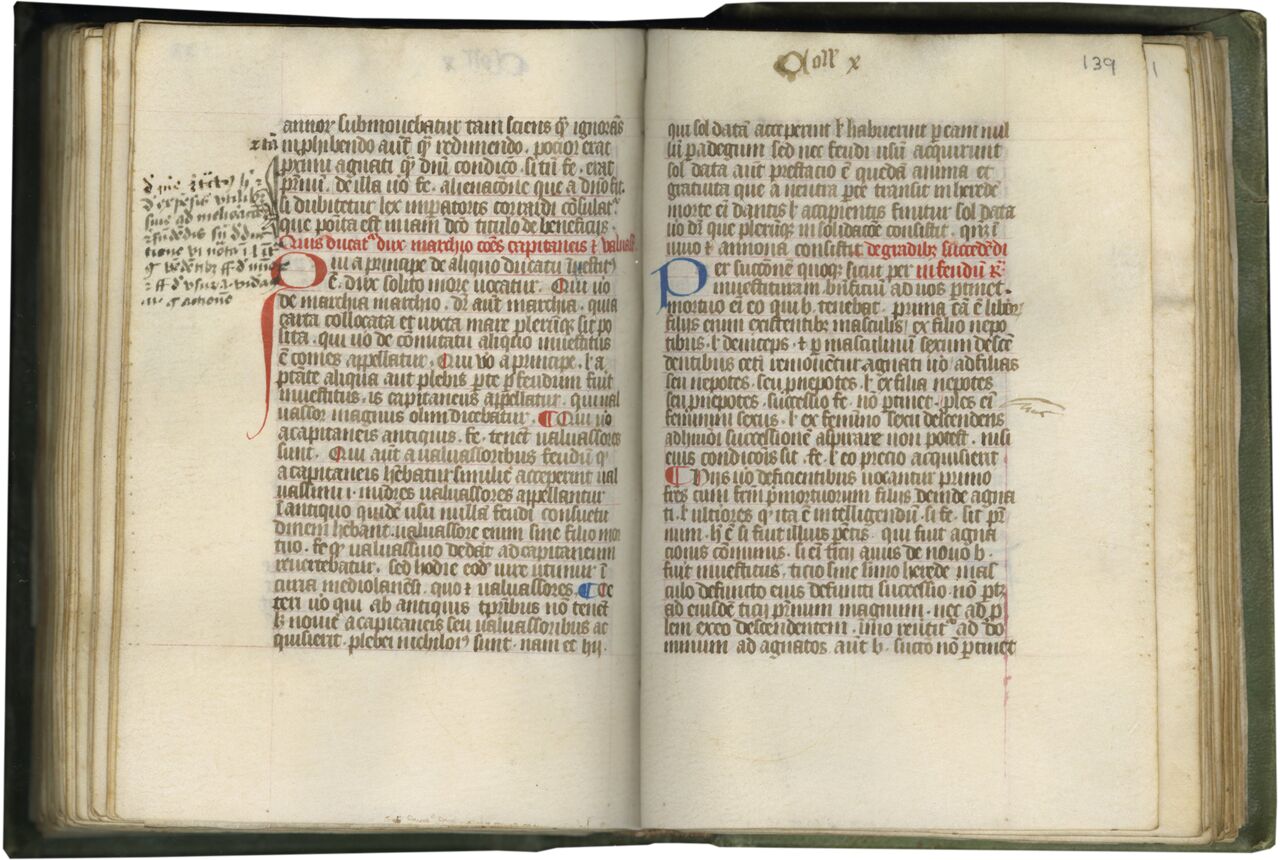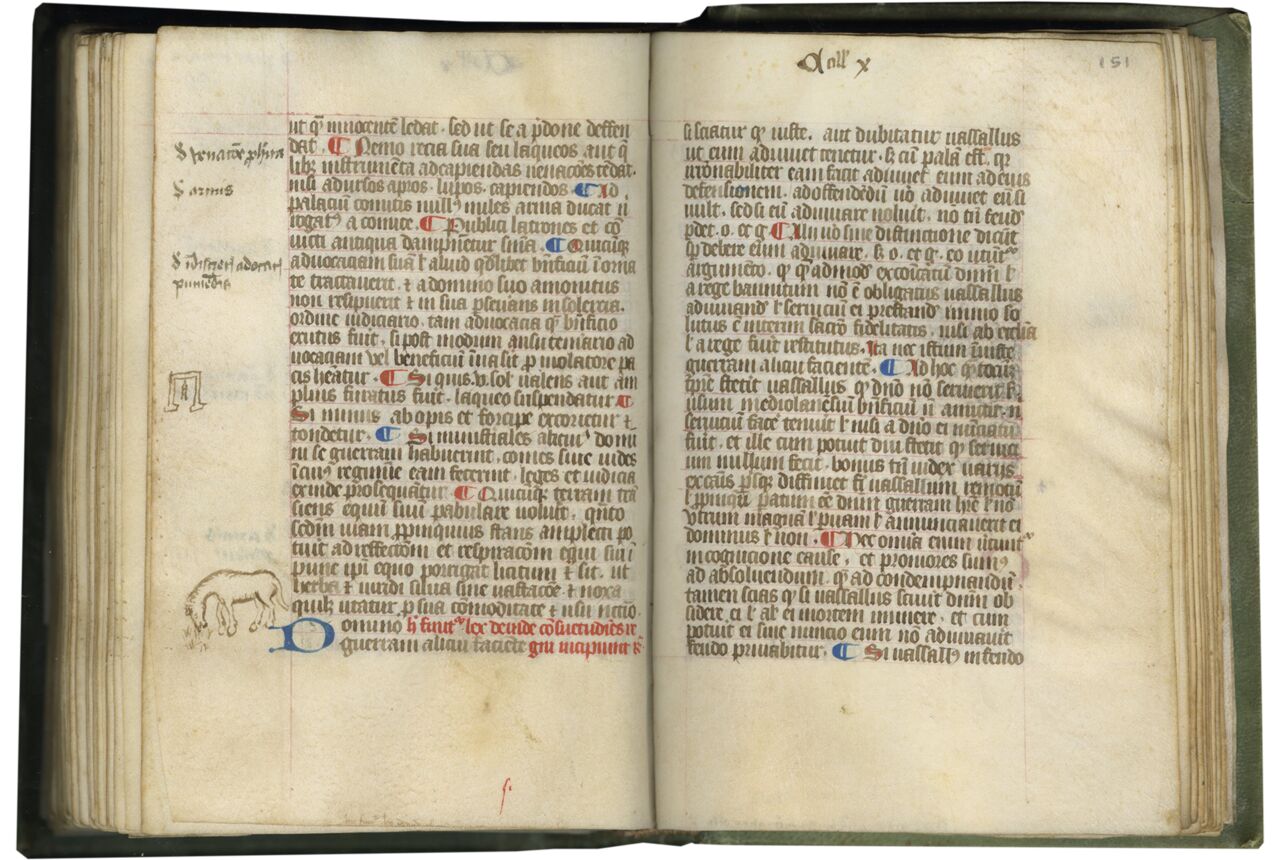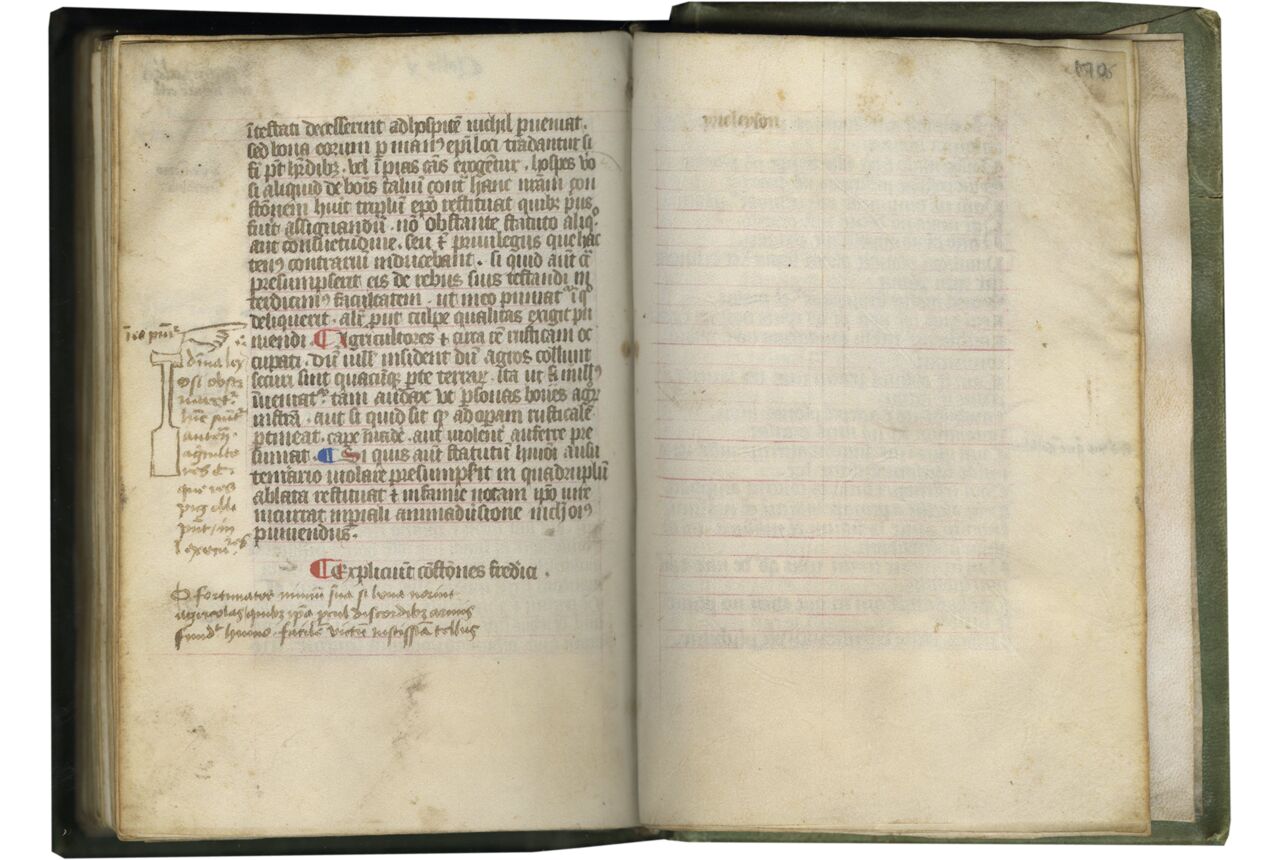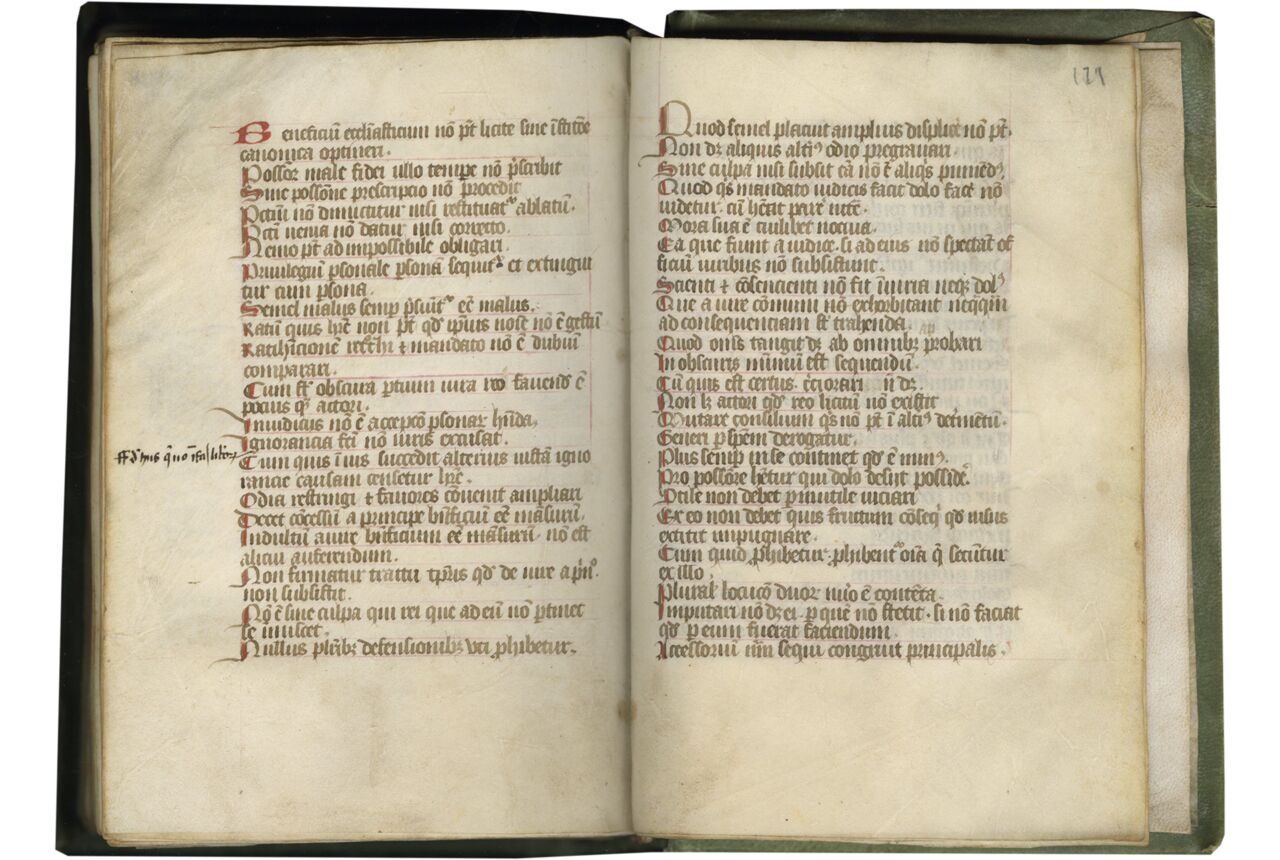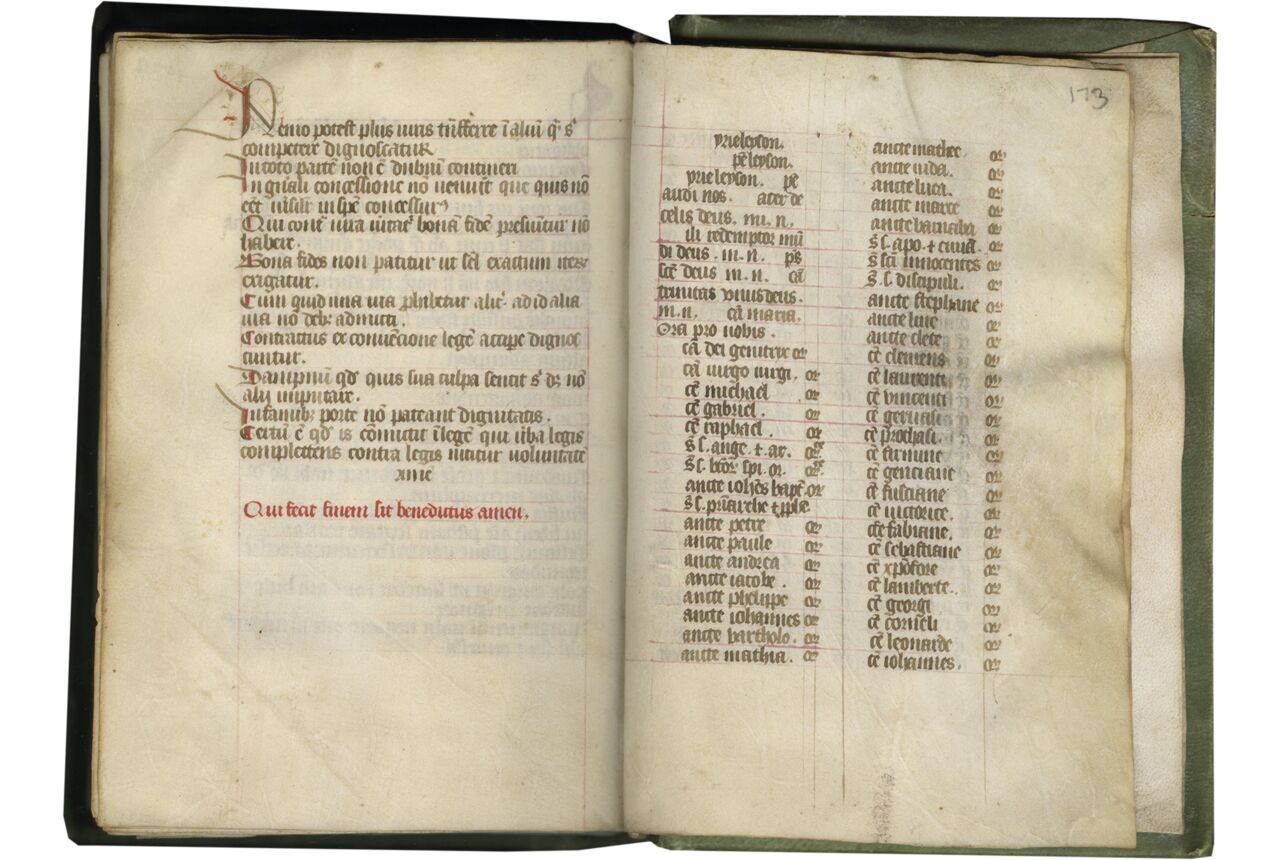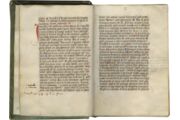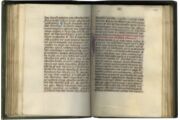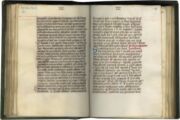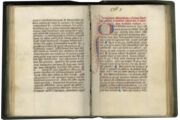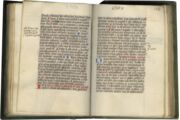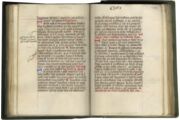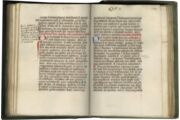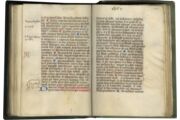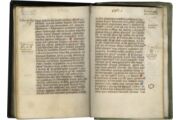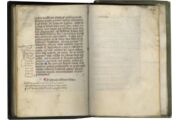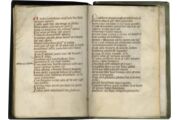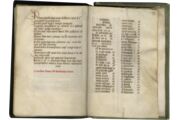172 folios on parchment (middling quality with occasional visible striations) + ii parchment flyleaves, modern foliation in pencil omitting ff. 168 and 169 in error (no loss of text), lacking two leaves (collation i-xv8 xvi6 [-5,-6, two leaves cut out after f. 124 with loss of text] xvii-xxi8 xxii8), catchwords, some decorated, at the end of quires ii-vii, x-xii, xiv-xv, xvii-xxi, ruled in red ink with the top and bottom two rules full across, single full-length bounding lines prickings three outer margins (justification 108 x 71 mm.), written below the top line by a single scribe in an upright Gothic textualis in 28 long lines, instructions to the rubricator occasionally remain, red rubrics, alternating red and blue paragraph marks, red and blue penwork initials at the beginning of each book of the Institutiones (ff. 1, 20, 59, and 93) and the beginning of the Liber Feudorum (f. 125), added marginal drawings pertaining to the text (discussed below), bottom right of front flyleaf cut to reveal library stamp, opening and closing folios darkened, overall good condition. Bound in eighteenth-century green parchment over pasteboard, sewn on five bands interspersed with parchment for reinforcement, spine with six raised bands and gilt decoration and title in gilt on red leather, “Codex iustiniani,” discoloration suggesting there was also once a label on the front cover, noticeable wear from folding with cracking along the cover’s edges and joints, bowing boards, but otherwise in good condition. Dimensions 161 x 115 mm.
This small, portable volume of legal texts was likely a personal reference copy for a notary or ecclesiastical official in his day-to-day work. Frequently annotated but, unusually, lacking a marginal gloss, the manuscript gathers texts on civil law (the Institutes), customary law (the Book of Fiefs, which was incorporated the Corpus iuris civilis in the later Middle Ages), and Canon Law, the Regulae iuris of Boniface the VIII. The litany of saints, a liturgical text, copied at the end underlines the highly personal nature of this miscellany. The Institutes and the Book of Fiefs are now rare on the market, despite their importance to both medieval jurisprudence and modern historiography.
Provenance
1. Copied in Northeastern France, perhaps in Amiens, in the third quarter of the fifteenth century, after 1455. The saints included in the Litany, in particular the martyrs Firmin, Fuscien, Victoric, and Gentien have strong links with Amiens (discussed below); the litany also includes the confessors Bernardinus of Siena, canonized in 1450 and Vincent, likely Vincent of Ferrer, canonized in 1455. This date and localization is also supported by the style of the script and decorated penwork initials, and details of production, including the ruling in red ink (compare for example, an Office lectionary for use of Amiens, dated 1405, Amiens, Bibliothèque Centrale Louis Aragon, MS 153, sharing some details of the penwork initials found in our manuscript despite its earlier date).
2. Signs of use include marginal notations, manicules (pointing hands), and corrections by four hands (original plus at least three additional, one medieval, one medieval or early modern, and one modern), as well as a number of simple drawings, added to the margins to call attention to subjects discussed in the text (discussed below).
3. Belonged to the Franciscan monastery of Sancta Maria Annunciata at Varese (near Lake Como); their stamp, a circle divided into four parts with the letters, SMAV, on f. 1 and 174v. This stamp was identified in eleven manuscripts and in nine incunables by Watson many books from this library are now in the British Library (Watson, 2004). An Observant House from c. 1469; its church was consecrated in 1476 (Moorman, 1983, p. 500). In 1725 they sold a number of their possessions, possibly including manuscripts, to finance an enlargement of their church, and certainly additional books were likely alienated over the course of the century. In 1810 when the church and convent were suppressed, however, their library was still considerable (some of their books were burned at this time; others were dispersed to various libraries, including the Biblioteca Civica of Varese, and the Biblioteca Queriniana of Brescia).
4. Modern owners’ and seller’s marks, in pencil front pastedown, including “156/7/3” and in ink on f. 174v, “922.”
5. Sold at auction, Munich, Hartung & Hartung, Auction 60, 1989, lot no. 15a.
Text
ff. 1-124v, In nomine domine Ihesu Christi imperator cesar flavius iustinianus… prohemium, incipit, “Imperatoriam maiestatem non solum armis decorata … ex latioribus digestorum seu pandectarum libris deo propitio adventura est”;
Justinian, Institutiones, ed. Krueger and Mommsen, 2000, v. 1, pp. 43-56. The Institutiones is one of three parts of the Corpus Iuris Civilis, compiled and promulgated by Roman Emperor Justinian I (d. 565) in the sixth century. Along with the Institutes, the Corpus of Civil Law included the Codex, a compilation of imperial edicts, and the Digesta, a compilation of legal extract (a fourth book, the Novellae Constitutiones, containing edicts of Justinian himself, was later added). The Corpus was assembled as part of Justinian’s legal reforms, which were key to his attempt to centralize his power and breathe new life into an Empire that had been in decline after losing control of its western provinces over the course of the previous century. Forgotten for most of the early Middle Ages, the Corpus became the center of a revival in Roman law starting at the nascent university in Bologna in the eleventh century. The text was copied widely for centuries, often with an explanatory marginal gloss, which was itself compiled and regularized by the Florentine jurist Accursio di Bagnolo (d. 1263) in the thirteenth century.
The Institutes (535 C. E.) was intended as a sort of legal textbook for law schools and included extracts from two major works, the Codex and the Digest. The prologue is addressed to “the youth desirous of studying the law,” and continues, “The imperial majesty should be armed with laws as well as glorified with arms, that there may be good government in times both of war and of peace, and the ruler of Rome may not only be victorious over his enemies, but may show himself as scrupulously regardful of justice as triumphant over his conquered foes…. Receive then these laws with your best powers and with the eagerness of study and show yourselves so learned as to be encouraged to hope that when you have compassed the whole field of law you may have ability to govern such portion of the state as may be entrusted to you.” This text has remained a resource for legal scholars by presenting a more accessible, rationally ordered, and concise summary of the main concepts of Roman Law than the much larger and more comprehensive Digest.
f. 124v, 11-28, [Unidentified gloss], incipit, “Iustiniani Augusti ut liber servus fiat sunt ista necesse annis xx iuvenem qui venditur esse… … Conventio dat leges contractus tricenale possessio huius aci habitatio mandato comperatur//”;
This fragment of text which immediately follows the Institutiones bears the hallmarks of a marginal gloss: it is composed of quotations from the Institutiones interspersed with explanations and citations from other sources. However, its position as part of the main text block, rather than in the margins, is very unusual. It appears to end imperfectly, and is followed by two stubs, suggesting loss of text is possible at this point in the manuscript; alternatively, we can imagine that this passage and possibly additional glosses were copied in error by the scribe, and then excised to prevent confusion.
ff. 125-165, Hic incipiunt constitutiones feudorum et primo de hiis qui feudum dare possunt…, incipit, “Quia de feudis tractaturi sumus videamus primo qui feudum dari possunt … qualiter quis se defendere debet, lex si contingeret”;
Libri feudorum versio vulgata, ed. Lehmann, 1896, and Stella, 2023, pp. 56-196 (with English translation). The Libri feudorum is a compilation of texts pertaining to the acquisition and holding of fiefs which originated in Lombardy in the twelfth century. This text has become central to many modern scholarly discussions of the concept of “feudalism,” following the groundbreaking publications by E. A. Brown (1974) and Susan Reynolds (1994) (see Stella, 2023). In its earliest iteration, called the Antiqua, it was composed of eight tracts written between c. 1100-1150. Additions of material from Milan over the second half of the century generated a second version, misleadingly named Ardizzoniana after the jurist Jacob de Ardizone. The text in our manuscript is a final, third iteration called the Vulgata, which included legislation from the Holy Roman Emperors Lothair III and Frederick I and was based on a version compiled by Accursio in the thirteenth century. This version circulated in manuscripts of the Corpus iuris civilis, where it was copied after Justinian’s Novels (then known as the Authenticum), becoming the only customary legal text in this body of civil law. The text, reflecting its importance, survives in numerous manuscripts (see “Fama,” Online Resources, stating there are 160 manuscripts; “Mirabile” Online Resources for a list of more than 155, none listed in US collections; and Weimar, 1997). The Libri feudorum was usually accompanied by a marginal gloss; its absence here is likewise notable. Nevertheless, the notes, drawings, and other marks in the margins of our manuscript testify to its use.
ff. 165-167v, De statutis et consuetudi circa libertatem ecclesie editus, incipit, “Ad decus et decorem imperii et laudem romani principis nichil magis videtur accedere… ipso iure incurrat inperiali animadversione nichilominus puniendus,” Expliciunt constitutiones Frederici;
Frederick II, Constitution of Emperor Frederick II, November 22, 1220, ed. Weiland, 1896, pp. 107-109; and Huillard-Bréholles, 1852-1861, vol. 2, part 1, pp. 3-7. This edict of Holy Roman Emperor Frederick II (d. 1250) promulgated on the day of his coronation protected the privileges of the Church. It often accompanied texts of the Book of Fiefs, and the edict itself required that it should be inserted into copies of the Corpus at the university of Bologna. With the title De statutis et consuetudinibus contra libertatem ecclesiae editis et immunitatem locorum religiosorum ubique morantium et fori privilegio et Gazaris et Patarenis et aliis haereticis eorumque successoribus et navigiis peregrinis et advenis quocunque locorum hospitantibus eorumque successoribus et de agricolarum securitatibus it was included in the early edition of the Corpus iuris civilis printed in Lyon c. 1498-1500 (GW 7772).
[ff. 168-169, omitted in foliation; f. 170, ruled but blank (“[k]yrieleyson” erased)]
ff. 170v-172, incipit, “Beneficium ecclesiasticum non potest licite sine institutione canonica optineri … Certum est quod is commictit in legem qui verba legis complectens contra legis nititur voluntatem, amen.” Qui fecit finem sit benedictus amen;
Boniface VIII, Regulae iuris, ed. Miller, 2013; and Friedberg and Richter, 1881, vol. 2, cols. 1122-1124; Pope Boniface VIII (d. 1303) was a fierce advocate of papal supremacy, leading to conflict with King Philippe le Bel of France and the pope’s subsequent death at the hands of the king’s minions. This collection of eighty-eight legal maxims, general rules for interpreting laws, was included as the last title of the Boniface’s Liber Sextus. How widely they circulated as an independent text, as in this manuscript, is a matter for further research.
ff. 173-174v, Litany, lacking rubrics, concluding on f. 174v, with the prayer, incipit, “Fidelium deus omnium conditor … quam semper optaverunt piis supplicationibus consequantur qui.”
Litany including Lawrence, Vincent, Firmin, Gentian, Fuscien, Victoric, Lambert, Cornelius, Leonard, and John among the martyrs; included among the confessors, which begin with Leo and Nicholas, are Bernardinus (of Siena), Vincent (Ferrer), Arnulf, Gengulf, Veranus, Robert, and Louis. As discussed above (Provenance), this is evidence that our manuscript dates after 1455 (canonization of Vincent Ferrer). The links with Amiens suggested by these saints are strong. St. Firmin is the patron saint of Amiens, and Gentien, Fuscien, and Victoric are early martyrs of Amiens (their relics were discovered there in the seventh century, and they are likely depicted on the portal of the cathedral there; see Online Resources). There is a chapel dedicated to St. Nicholas in the cathedral at Amiens, as well as a twelfth-century church dedicated to him in the city.
Illustration
The Libri feudorum and Frederick II’s Constitution feature marginal drawings in an ink similar to that of the main hand which directly relate to the adjacent text. In the Libri feudorum, there is a hanged man next to “laqueo suspendatur” (they shall be hung by a noose) and a horse next to “transiens equum suum” (crossing on his horse) on f. 150v, and a hand with a quill next to “scriba vero” (a scribe, however) on f. 162v. In the Constitution there is a ship next to “naviga quocumque” (you will sail in any place) and a scallop shell next to “omnes peregrini” (all pilgrims) on f. 167, and a shovel next to “agricultores” (farmers) on f. 167v. Marginal drawings of this type were used by readers (perhaps especially students) of legal texts as finding aids and as mnemonic devices (see L’Engle, 2011).
Several features of this manuscript set it apart from many extant law books from the Middle Ages, including its small format, miscellaneous contents, and lack of marginal gloss. The manuscript was designed for portability and ease of use. Because the Institiutiones was intended as a teaching text, it was a useful basic guide for those who wanted access to the law but did not need the encyclopedic coverage of the rest of the Corpus iuris civilis. The Libri feudorum, Constitution of Frederick II, and Boniface VIII’s Regulae, would have similarly been useful reference guides to the legal landscape of the late Middle Ages, as indicated by the frequent notations.
Literature
Barker, J. W. Justinian and the Later Roman Empire, Madison, 1966.
Brown, Elizabeth A. R. “The Tyranny of a Construct: Feudalism and Historians of Medieval Europe,” American Historical Review 79 (1974), pp. 1063–1088
Friedberg, Emil and Aemilius Ludwig Richter, eds. Corpus iuris canonici. Tauchnitz, 1881, v. 2, cols. 1122–1124.
L’Engle, Susan. “The Pro-active Reader: Learning to learn the law,” Medieval Manuscripts, Their Makers and Users. A Special Issue of Viator in Honor of Richard and Mary Rouse, Turnhout, 2011, pp. 51-75.
Huillard-Bréholles and Jean-Louis-Alphonse. Historia diplomatica Friderica Secundi : sive constitutiones, privilegia, manata instrumenta quae supersunt istitus imperatoris et filiorum ejus …, Paris, 1852-1861.
Krueger, Paul and Theodor Mommsen, eds. Corpus Iuris Civilis. Volumen Primum. Institutiones ..., Hildesheim, 2000 (reprint of Mommsen, et al., Berlin, 1893-1928, see below).
Lehmann, Karl, ed. Das Langobardische Lehnrecht (Handschriften, Textentwicklung, ältes ter Text und Vulgattext nebst den capitula extraordinaria), Göttingen, 1896; repr. Aalen, 1971.
Mazzoleni, J. Lezioni di paleografia latina e diplomatica, v. 2, Naples, 1964.
Miller, B. “The Sacramental Life of the Parish: An Encounter with Justice,” Canon Law Society of America. Proceedings of the Seventy-Fourth Annual Convention Chicago, Illinois, October 8-11, 2012, Washington, D.C, 2013.
Mommsen, Theodor, Paul Krüger, R. Schöll, and G. Kroll, Corpus iuris civilis, Berlin, 1893-1928.
Montbach, M. de. Statuta synodalia dioecesana ecclesiae Wratislaviensis, Nischkovsky, 1855.
Moorman, John. Medieval Franciscan Houses, St. Bonaventure, New York, 1983.
Radding, C. M. and A. Ciarelli. The Corpus Iuris Civilis in the Middle Ages, Leiden and Boston, 2007.
Repertorium fontium historiae medii aevi primum ab Augusto Potthast digestum, nunc cura collegii historicorum e pluribus nationibus emendatum et auctum. 11 volumes, 1962-2007, volume 7, pp. 289-290.
Reynolds, Susan. Fiefs and Vassals. The Medieval Evidence Reinterpreted, Oxford, 1994.
Stein, P. The Character and Influence of the Roman Civil Law, London, 1988.
Stella, A. The Libri Feudorum (the “Books of Fiefs”), Leiden and Boston, 2023.
Taunton, E. The Law of the Church: A Cyclopaedia of Canon Law for English-Speaking Countries, London, 1906.
Thomas, J. A. C. The Institutes of Justinian. Text, Translation and Commentary, Amsterdam and Oxford, 1975.
Watson, Anrew. “A Varese Library-Stamp Identified?,” in Medieval Manuscripts in Post-Medieval England, New York, 2024, no. 15, and “Additional Notes,” pp. 14-17.
Watson, A. Medieval Manuscripts in Post-Medieval England, New York, 2024.
Weiland, L., ed. Constitutiones et acta publica imperatorem et regum 1198-1272, MGH Leg. IV., Hannover, 1896, vol. 2, pp. 107-109.
Weimar, P. “Die Handschriften des Liber Feudorum und seiner Glossen,” in Zur Renaissance der Rechtswissenschaft im Mittelalter, Goldbach, 1997, pp. 31-237
Online Resources
Justinian, Institutes (in English)
http://www.gutenberg.org/files/5983/5983-h/5983-h.htm
On the Institutes
http://www.historyguide.org/ancient/justinian.html
Liber feudorum (manuscripts)
https://www.mirabileweb.it/title/libri-feudorum-title/173022
Liber feudorum
FAMA - Œuvres latines médiévales à succès : Libri feudorum
Life of a Cathedral: Notre-Dame of Amiens (Columbia University, 2017)
https://projects.mcah.columbia.edu/amiens-arthum/content/north-portal-3
TM 1410


